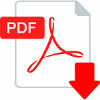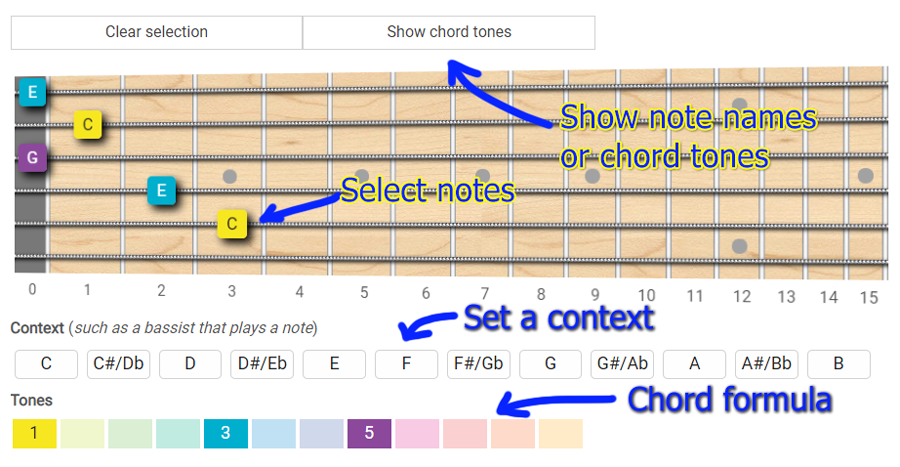Guitar Chords
The Complete Beginner to Advanced Guide
This page will help you advance your guitar chords knowledge from A to Z.
We're going to learn the most common shapes for beginners, moving to intermediate fingerings, and then we'll deal with chords theory to see how to create chords of any quality across the entire fretboard.
On this page you'll also find a complete chords library with voicings of all kinds, an interactive chord generator, and my complete ebook Chords Domination | Play Any Chord You Want Across All The Fretboard.
So let's get started!
Interactive Tool: Your First 10 Chords
Guitar Chord Types
In the following table we go over all guitar chords: minor, major, dominant, augmented, suspended, diminished, extended, altered and more types of chords.
It shows you how the proper way to place your fingers to play a given chord, but also tells you the name of the notes that compose that chord, and even the intervals in the chord.
Just click on any chord box name to see all the possible qualities, fingerings and variations:
How To Read Chord Diagrams
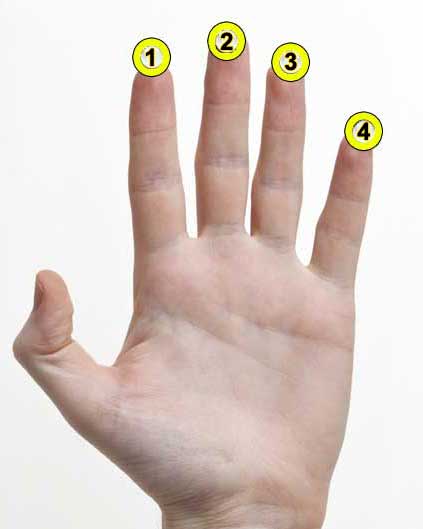
To show you how to read the chords diagrams above, let's use the A chord as an example. For the purposes of chord diagrams, here is how your left-hand fingers are numbered.
As you will notice:
- The index finger is denoted with number 1
- The middle with 2
- The ring finger with 3
- The pinky with 4.
These numbers are used on the diagrams to show you what fingers use for pressing the frets composing the chords.
Chords Diagrams
Example: A Major chord
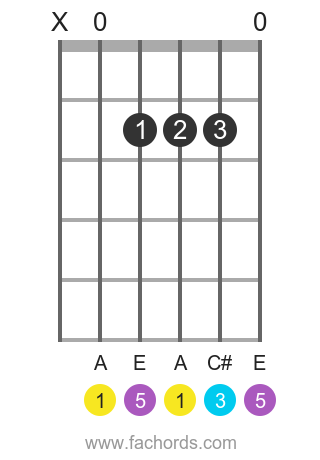 The diagram on the left shows you the fretboard on the guitar, with the thickest string on the
left, and
the E high string on the right.
The diagram on the left shows you the fretboard on the guitar, with the thickest string on the
left, and
the E high string on the right.
The numbers over the frets tell you where to press the string. At the top of the diagram, you see an X or a 0 in near the strings.
The X tells you to mute the string (not play it at all), the 0 tells you to play it open, without pressing any frets. So, in order to play the A chord as shown in the diagram, you should:
- Do not play the E lowest string (as stated by the X above the E low string)
- Play the 5th string (A string) open, without pressing any fret (see the 0 above the A string?)
- Press the fret n.2 of the 4th string (D string) with the index finger
- Press the fret n.2 of the 3rd string (G string) with the middle finger
- Press the fret n.2 of the 2nd string (B string) with the ring finger
- Let resonate the 1st string (E high string) open, without pressing any fret
Drill down: Check the complete tutorial on how to read chord diagrams, with instructions on intervals and chord structures.
Beginner Guitar Chords
Here below, you find the chord diagrams with basic instructions for playing the most used chords that beginners should learn first .
Take your time to learn these shapes; if you've just started with guitar, it might take some time to play them smoothly.
C Major Chord
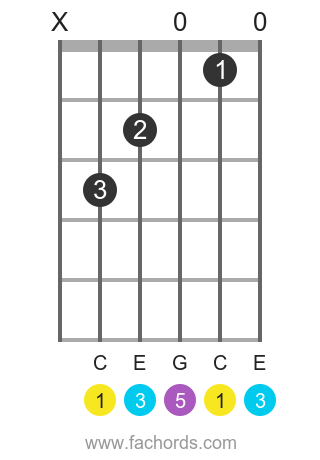
This is the most common way to play the C major chord on the guitar.
Be careful not to play the E lowest string.
How to play the C major chord:
- Mute the low E string
- Let the G string play without pressing any fret
- Let the high E string play without pressing any fret
- Place your index finger (1) on the fret 1 of the B string
- Place your middle finger (2) on the fret 2 of the D string
- Place your ring finger (3) on the fret 3 of the A string
C Major (super easy)
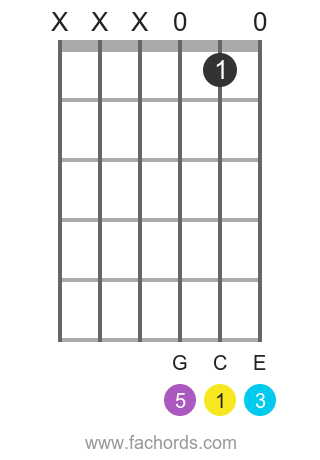
This is an easier version that uses only 3 strings and requires only your index finger.
To play this super easy version of the C major chord:
- Mute the three lowest strings (low E, A and D)
- Let the G string play without pressing any fret
- Let the high E string play without pressing any fret
- Place your index finger (1) on the fret 1 of the B string
A Major Chord On Guitar

To play the basic A major chord position , you have to use three fingers: index, middle and ring.
- Mute the low E string
- Let the A string play without pressing any fret
- Let the high E string play without pressing any fret
- Place your index finger (1) on the fret 2 of the D string
- Place your middle finger (2) on the fret 2 of the G string
- Place your ring finger (3) on the fret 2 of the B string
G Major Chord
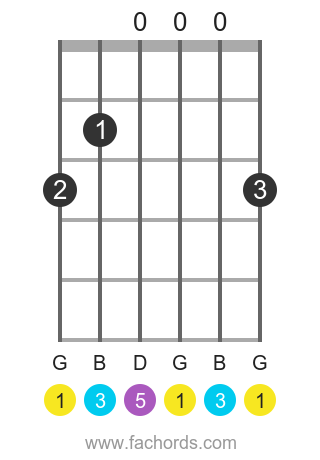
This is the most common fingering for the G major chord.
- Let the D string play without pressing any fret
- Let the G string play without pressing any fret
- Let the B string play without pressing any fret
- Place your index finger (1) on the fret 2 of the A string
- Place your middle finger (2) on the fret 3 of the low E string
- Place your ring finger (3) on the fret 3 of the high E string
G Major (super easy)
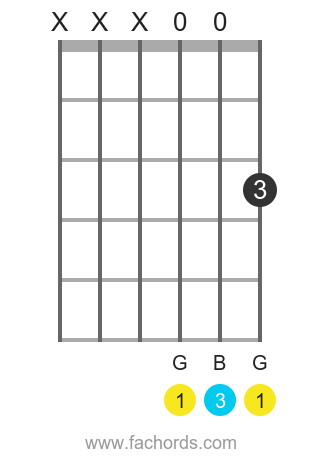
Another more accessible version, this G major shape needs only one finger.
- Mute the three lowest strings (low E, A and D)
- Let the G string play without pressing any fret
- Let the B string play without pressing any fret
- Place your ring finger (3) on the fret 3 of the high E string
E Major Chord On Guitar
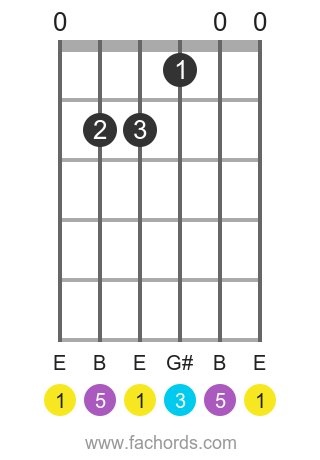
With this E major chord you should strum all the strings.
- Let the low E string play without pressing any fret
- Let the B string play without pressing any fret
- Let the high E string play without pressing any fret
- Place your index finger (1) on the fret 1 of the G string
- Place your middle finger (2) on the fret 2 of the A string
- Place your ring finger (3) on the fret 2 of the D string
E Major (super easy)
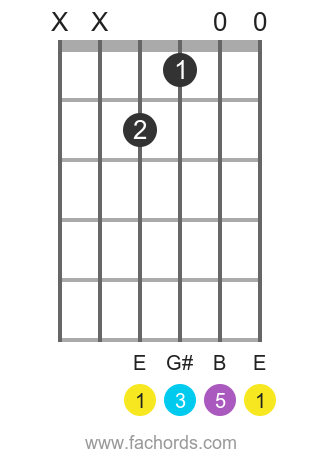
Here's a stripped-down version of the E major chord that you can play with only two fingers
- Mute the tow lowest strings (E and A)
- Let the B string play without pressing any fret
- Let the high E string play without pressing any fret
- Place your index finger (1) on the fret 1 of the G string
- Place your middle finger (2) on the fret 2 of the D string
How To Play D Major on Guitar
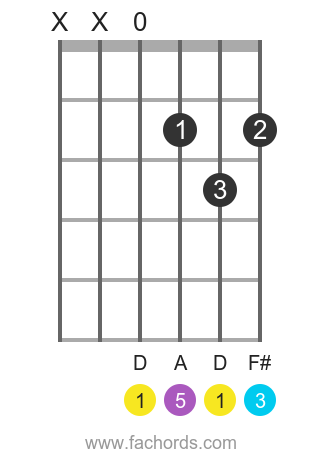
This is the standard way to play the D major chord on the guitar
- Mute the low E and A strings
- Let the D string play without pressing any fret
- Place your index finger (1) on the fret 2 of the G string
- Place your middle finger (2) on the fret 2 of the high E string
- Place your ring finger (3) on the fret 3 of the B string
A Minor Chord
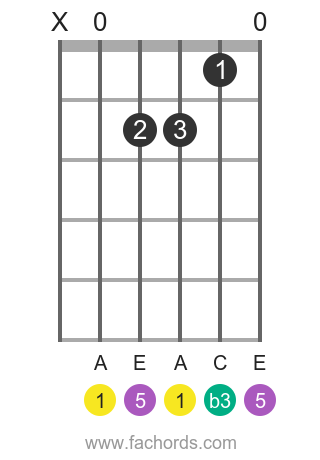
Another fundamental chord, the A minor , that you can find in many ballads and sad songs.
- Mute the low E string
- Let the A string play without pressing any fret
- Let the high E string play without pressing any fret
- Place your index finger (1) on the fret 1 of the B string
- Place your middle finger (2) on the fret 2 of the D string
- Place your ring finger (3) on the fret 2 of the G string
A Minor (super easy)
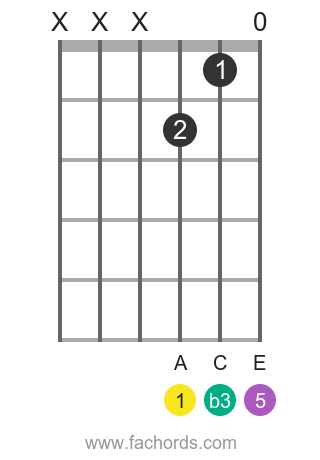
Here's the more relaxed version of the A minor chord
- Mute the three lowest strings (low E, A and D)
- Let the high E string play without pressing any fret
- Place your index finger (1) on the fret 1 of the B string
- Place your middle finger (2) on the fret 2 of the G string
E minor Chord
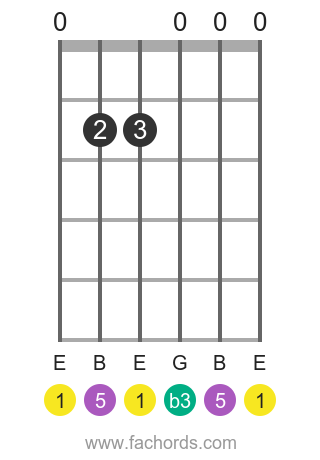
This version of the E minor chord requires only two fingers
- Let the low E string play without pressing any fret
- Let the G string play without pressing any fret
- Let the B string play without pressing any fret
- Let the high E string play without pressing any fret
- Place your middle finger (2) on the fret 2 of the A string
- Place your ring finger (3) on the fret 2 of the D string
E minor (super easy)
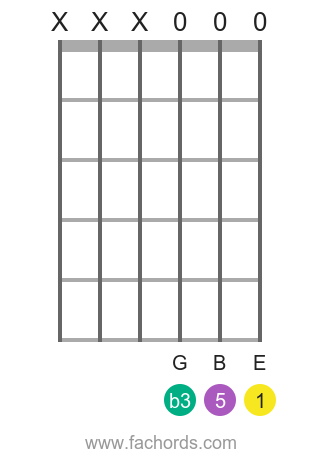
It's not a joke; this shape for the E minor chord does not require to press any fret. If you ever tried to play " Nothing Else Matter " by Metallica, the first bars use only open strings
- Mute the three lowest strings (low E, A and D)
- Let ring the three higher strings (G, B and high E)
D Minor Chord
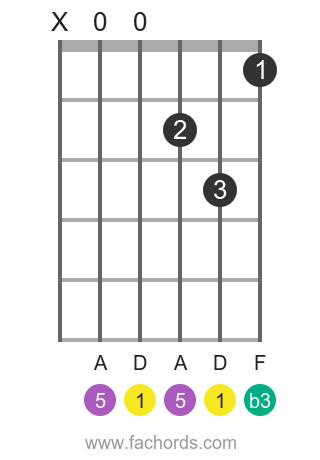
This is the last basic chord taught in this tutorial.
- Mute the low E and A strings
- Let the D string play without pressing any fret
- Place your index finger (1) on the fret 1 of the high E string
- Place your middle finger (2) on the fret 2 of the G string
- Place your ring finger (3) on the fret 3 of the B string
Tips for Beginners: How To Practice YOur First Chords
Here are some tips for practicing chords:
- Press the strings with only the tip of the fingers (it hurts at the beginning, but be patient, calluses will come soon)
- Place your fingers close to the metallic frets
- Your fingertips should be perpendicular to the fretboard, so that they do not touch the other strings
- Play the chords one string at a time and check if each note sounds well
- Press the strings as much as needed to let the notes ring clear, not more
- Choose two chords and practice switching between them. Then do the same exercise with three and four chords.
A Note About Open Chords
 Open chords make use of open strings as much as possible.
Open chords make use of open strings as much as possible.
They are easier to play because they require to press less frets. Usually, beginners start by learning major and minor open chords.
A basic major chord consists of the root note, the 3rd, and the 5th, so a G chord would be made up of the notes G, B and D, while a minor chord is formed by the root, minor 3rd and the 5th, so a G minor chord is G, Bb and D.
Drill Down: find the first open guitar chords that a beginner should learn.
Power Chords
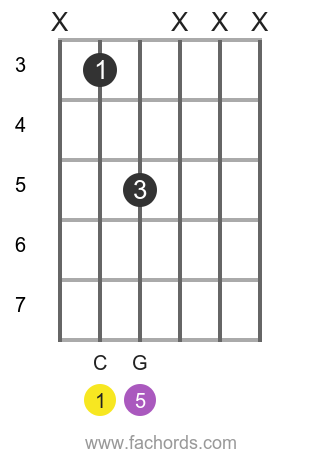 Another great start for beginners, the power chord is a common
element in
rock and blues (technically is not a chord, but a dyad, two notes played
together).
Another great start for beginners, the power chord is a common
element in
rock and blues (technically is not a chord, but a dyad, two notes played
together).
A power chord is only made up of the first and the fifth, so a G power chord would be the notes G and D.
Power chords are often played on the 3 lowest strings of the electric guitar (E low, A and D), most often ignoring the treble strings.
Drill Down: jump to the complete power chords tutorial to learn more.
Intermediate Guitar Chords
We have compiled a list of 15 intermediate guitar chords you should learn, in order to play more complex chords.
And then, it's time to deal with...
Bar Chords
 Bar chords require pressing more than one fret with the same finger.
Bar chords require pressing more than one fret with the same finger.
That's the reason why they are difficult at the beginning when you don't have enough strength.
The great thing about bar chords is that they are movable: you can shift the same shape up or down the fretboard to play any chord.
We can have a full bar chord, like the F major chord (6 strings pressed with the index finger) or partial bar chords.
Drill Down: 7 Tips To Make Bar Chords Easier. Bar chords are a big difficulty for beginners. In this guide I'll provide you with some tips that will make your life easier.
Dominant Chords
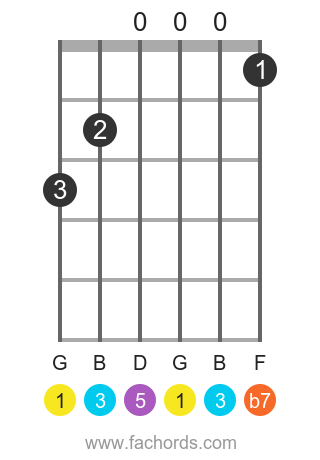 Dominant chords are major chords with a minor seventh, so they are a kind of 4 tones
chords.
Dominant chords are major chords with a minor seventh, so they are a kind of 4 tones
chords.
So the G dominant chord is the G major chord, G, B and D, plus F, which is the seventh of G.
Dominant chords play a crucial role in chord progressions, because they introduce a tension that drives the songs to the home chord.
Drill Down: learn more about 7th dominant chords and their extended form, the Ninth chord.
Diminished Chords
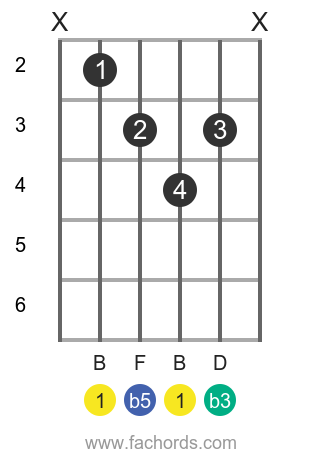 Diminished chords are used to create dissonance and anticipation, which usually are resolved to more
relaxed chords.
Diminished chords are used to create dissonance and anticipation, which usually are resolved to more
relaxed chords.
There are 3 main types of diminished chords:
- Diminished triad (1, b3, b5)
- Half diminished chord (1, b3, b5, b7)
- Diminished 7th chord (1, b3, b5, bb7)
Drill Down: learn all the types of diminished chords.
Suspended Chords
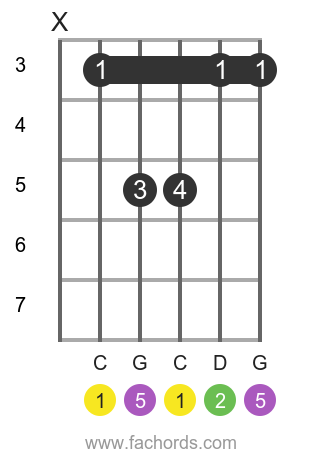 Suspended chords are a particular kind of chord that is neither major nor minor.
Suspended chords are a particular kind of chord that is neither major nor minor.
They are often used to create tension and are a great weapon to have in your songwriting arsenal.
Suspended chords come in two flavours: sus2 (1, 2 and 5), and sus4 (1, 4 and 5).
Drill Down: learn all about suspended chords for guitar.
Sixth Chords
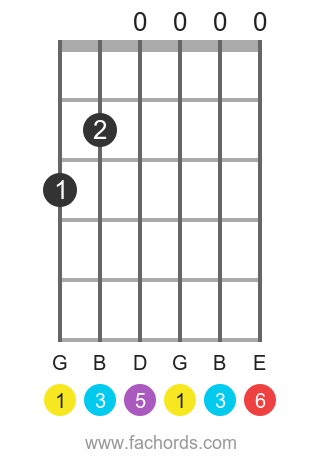 If you want to be casual and chill in your music, we need to use the 6th chord.
If you want to be casual and chill in your music, we need to use the 6th chord.
A sixth chord is a major chord with a major sixth added: 1,3,5 and 6 (G, B, D and E in the case of G6)
Drill Down: learn more about 6th chord construction and applications..
Advanced Guitar Chords
If you have been studying guitar chords for some time, you are already aware that chords are more than static shapes to memorize. In fact, you can assemble intervals on the fly to create chords of all qualities across the entire fretboard.
This C variations tutorial is great for understanding the various types of chords that emerge depending on the intervals you use.
A great way to skyrocket your chord knowledge is to see the fretboard as a whole, with the help of a fretboard map, and try to spot all the possible combinations of the tones that create a given chord quality. Be sure to include all inversions.
For example, try to form as many as possible C maj7 chords using the map below. A C maj7 is 1, 3, 5 and 7.
Often, you can drop the 5 because it does not bring any harmonic richness, like in shell chord shapes.
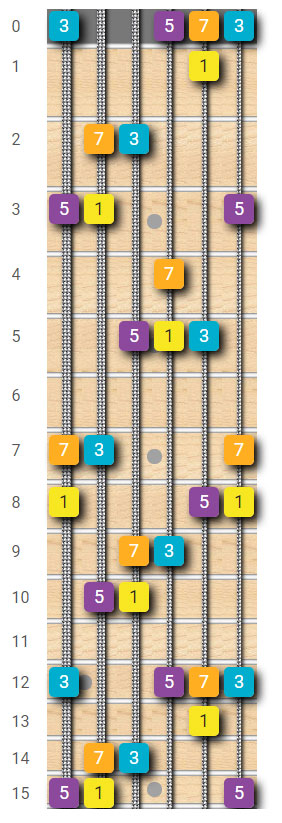
Drill Down: experiment new chord shapes with my chord generator tool .
Guitar Chords: More Tips And Tricks
Fingers positions are just a suggestion!
A Major chord with bar fingering
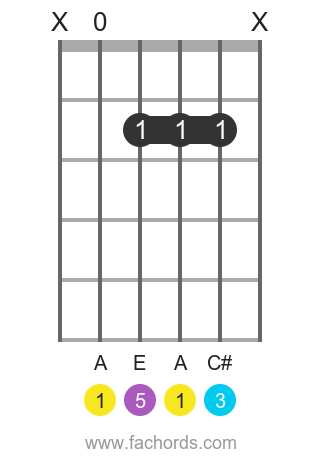 Sometimes, you'll find somewhere a chord diagram that does not show you the finger numbers.
Sometimes, you'll find somewhere a chord diagram that does not show you the finger numbers.
They will leave that up to you because different people sometimes play chords differently.
Some people cannot play an A chord like this, because their fingers are too big, and this fingering is very cramped for them.
Instead, they play an A with a mini-barre, using the same finger for more frets.
For example, I could bar my 1st finger across the 4th, and 3rd strings at the second fret, then place my 2nd finger on the 2nd string, second fret (see image on the left).
This gives me more room between the frets, and also frees up my 3rd and fourth fingers to pick out melody and bass notes. It's just a preference, you can play the chord how you prefer.
If you start thinking about chords as shapes, or forms, it makes it easier later on when you want to play the same shapes up and down the neck for different chords, as well as for finger-style techniques.
Some "shapes" lend themselves better for some techniques, such as flat-picking, finger-style, and other applications.
At the bottom of the diagrams you can see the name of the note on the corresponding string, and some colorful circles
The letters inside the circle tell you what the intervals in the chord (root, major third, minor third, and so forth) are.
The colors change according to the type of interval. For example, the root is always yellow.
Intervals are an intermediate topic that belongs to chords theory, you find a complete tutorial on chord construction here.
Drill Down: Did you come out with a shape that sounds pleasant, but you don't know how to name it? My guitar chord analyzer will help you analyze any chord you create.
Strumming Chords
Don't worry about getting the strumming patterns down perfectly.
You will develop your own strumming style in time. Just try to stay in time.
If you have to strum open strings in-between chords, while you switch from one to the other, that's OK, too. In fact, sometimes, it's even desirable. It's what we call 'style'.
You're main objective right now is learning the chord fingerings, and getting your changes smooth.
Let's play a simple song with only one chord, A major. You should already know the fingering for this chord, shown in the images above on this page.
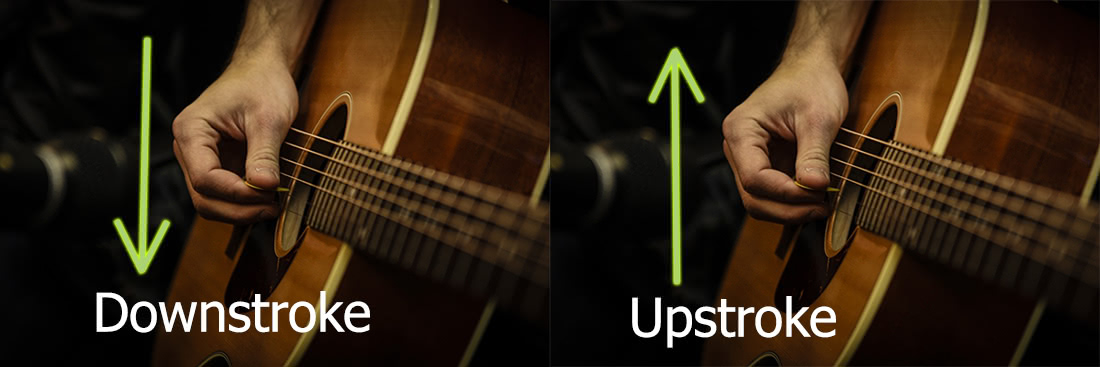
The song is in 4/4 time, which means the count is 1-2-3-4, 1-2-3-4, etc..
To develop proper strumming technique from first, do this:
- On 1, just hit the open A string, and let it ring.
- On 2, strum down from the A string.
- On 3, just hit the E string and let it ring.
- On 4, strum down from the A string.
- Repeat for every measure.
This gives you a wonderful bass line, and will dramatically improve your sound, as well as help you to develop a good rhythmic strumming style right from the first.
Singing the song is a matter of timing. Listen to the song a few times and you'll get it.
It's easier than trying to explain time signatures, and timing. You'll know when you get it right. Just keep listening.
Drill Down: learn 10 strumming patterns to practice daily for great improvement.
How To Build Guitar Chords
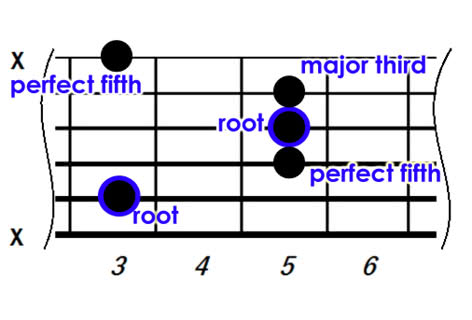
You may wondering how all these chord shapes has been constructed.
For now, you just need to know that a chord is based on the notes of a simple scale, which has 7 notes, and you finish on the original note, one octave up, for a total of 8 notes.
A Chord is three or more notes played simultaneously at specific intervals (remember, an interval is a note in a scale) that work together to create the desired sound.
One of the attributes that makes guitars (and pianos) so popular is that they are multi-timbral instruments, which means they can play more than one note simultaneously.
A basic Major chord is made up of the 1st note in the scale of whatever key you are playing in, also called the root note, the 3rd note, and the 5th note.
Woodwinds, brass, and similar instruments can only play one note at a time. To make a chord, they have to have a minimum of 3 players playing a single note in the chord at the same time.
Drill Down: To learn the foundation theory of chord building, so that you can create your own shapes, go to our guitar music theory tutorial.
How many chords should I learn?
Theoretically, there is an unlimited number of possible chords.
You could start from open chords, and move them up the fretboard and find hundreds of different shapes.
In actual play, you can get along just fine for quite a while with only around 30 chords in your repertoire, and maybe even less depending on what type of music you want to play.
There are bluegrass guitar players that have gone through entire careers never playing more than a dozen or so chords.
Many guitar players are used to transpose songs to a more familiar key (often with the help of a guitar capo).
If you are willing to go deeper into music theory and learn how to construct chords by combining intervals all along the fretboard, check my chord construction tutorial and my complete ebook Chords Domination | Play Any Chord You Want Across All The Fretboard.
How To Put Chords Together: Chord Progressions

Chords in a song are arranged according to chord progressions, which are chord intervals that works pretty much the same as single notes in a scale.
It's very important for you to learn chord progressions for the various keys, because then, as long as you know what key the song is in, you can figure out the chords in it very easily.
It's also crucial being able to change chords quickly and smoothly.
Drill Down: chord progressions are the foundation of any songs, learn them inside-out in my chord progressions guide any my complete ebook 52 Chord Progressions | Learn How To Connect Chords and Create Great Songs .
Now you should have a good understanding of what it takes to become a chord master. Take your time to practice and internalize these concepts.
To stay updated on new tutorials, subscribe to the free newsletter (you'll also get access to the download area with lots of free printable resources).
